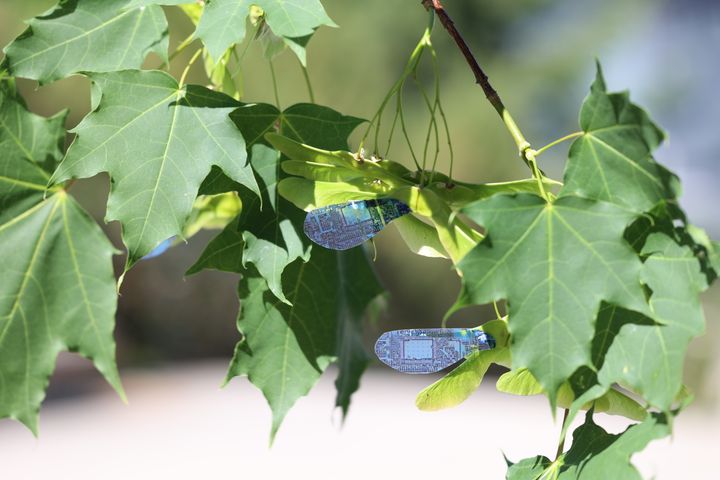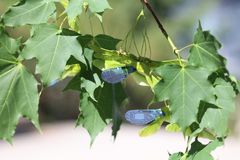Light-controlled artificial maple seeds could monitor the environment even in hard-to-reach locations
Researchers from Tampere University, Finland, and the University of Pittsburgh, USA, have developed a tiny robot replicating the aerial dance of falling maple seeds. In the future, this robot could be used for real-time environmental monitoring or delivery of small samples even in inaccessible terrain such as deserts, mountains or cliffs, or the open sea. This technology could be a game changer for fields such as search-and-rescue, endangered species studies, or infrastructure monitoring.

At Tampere University, Professor Hao Zeng and Doctoral Researcher Jianfeng Yang work at the interface between physics, soft mechanics, and material engineering in their Light Robots research group. They have drawn inspiration from nature to design polymeric gliding structures that can be controlled using light.
Now, Zeng and Yang, with Professor M. Ravi Shankar, from the University of Pittsburgh Swanson School of Engineering utilized a light-activated smart material to control the gliding mode of an artificial maple seed. In nature, maple disperse to new growth sites with the help of flying wings in their samara, or dry fruit. The wings help the seed to rotate as it falls, allowing it to glide in a gentle breeze. The configuration of these wings defines their glide path.
According to the researchers, the artificial maple seed can be actively controlled using light, where its dispersal in the wind can be actively tuned to achieve a range of gliding trajectories. In the future, it can also be equipped with various microsensors for environmental monitoring or be used to deliver, for example, small samples of soil.
Hi-tec robot beats natural seed in adaptability
The researchers were inspired by the variety of gliding seeds of Finnish trees, each exhibiting a unique and mesmerizing flight pattern. Their fundamental question was whether the structure of these seeds could be recreated using artificial materials to achieve a similar airborne elegance controlled by light.
“The tiny light-controlled robots are designed to be released into the atmosphere, utilizing passive flight to disperse widely through interactions with surrounding airflows. Equipped with GPS and various sensors, they can provide real-time monitoring of local environmental indicators like pH levels and heavy metal concentrations” explains Yang.
Inspired by natural maple samara, the team created azobenzene-based light-deformable liquid crystal elastomer that achieves reversible photochemical deformation to finely tune the aerodynamic properties.
“The artificial maple seeds outperform their natural counterparts in adjustable terminal velocity, rotation rate, and hovering positions, enhancing wind-assisted long-distance travel through self-rotation”, says Zeng.
In the beginning of 2023 Zeng and Yang released their first, dandelion seed like mini robot within the project Flying Aero-robots based on Light Responsive Materials Assembly – FAIRY. The project, funded by the Research Council of Finland, started in September 2021, and will continue until August 2026.
“Whether it is seeds or bacteria or insects, nature provides them with clever templates to move, feed and reproduce. Often this comes via a simple, but remarkably functional, mechanical design,” Shankar explains.
“Thanks to advances in materials that are photosensitive, we are able to dictate mechanical behavior at almost the molecular level. We now have the potential to create micro robots, drones, and probes that can not only reach inaccessible areas but also relay critical information to the user. This could be a game changer for fields such as search-and-rescue, endangered or invasive species studies, or infrastructure monitoring,” he adds.
The article "Photochemical Responsive Polymer Films Enable Tunable Gliding Flight" by Jianfeng Yang, M. Ravi Shankar, and Hao Zeng was published in Nature Communications on 1 June, 2024.
Avainsanat
Yhteyshenkilöt
Dr. Hao Zeng
hao.zeng@tuni.fi
Kuvat


Tampere University in brief
Tampere University brings together research and education in technology, health and society. Our collaboration with our partners is built on our strengths, unique combinations of scientific disciplines and applied expertise. We are working together to build a sustainable world. We develop solutions to tackle climate change, protect the natural environment and improve the well-being and sustainability of societies. There are 22,000 students and over 4,000 staff members at Tampere University. www.tuni.fi/en
Tilaa tiedotteet sähköpostiisi
Haluatko tietää asioista ensimmäisten joukossa? Kun tilaat tiedotteemme, saat ne sähköpostiisi välittömästi julkaisuhetkellä. Tilauksen voit halutessasi perua milloin tahansa.
Lue lisää julkaisijalta Tampereen yliopisto
Yhteenkuuluvuuden johtaminen voi olla avain työpaikan kasvuun10.11.2025 13:31:30 EET | Tiedote
Keskustelu suomalaisen johtamisen haasteista saa tuoreen näkökulman Tampereen yliopiston Työelämän tutkimuskeskuksen uudesta tutkimuksesta. Tulosten mukaan työpaikan yhteenkuuluvuuden – eli työyhteisön identiteetin – johtaminen voi olla ratkaiseva tekijä kasvun ja innovaatioiden synnyttämisessä. Vielä vaikuttavampia tuloksia saavutetaan, kun yhteenkuuluvuutta johdetaan yhdessä.
Väitös: Yhteisöllisyys ja yksilölliset voimavarat tukevat opiskelijoiden hyvinvointia poikkeusaikoina10.11.2025 11:10:45 EET | Tiedote
Väitöstutkimuksessaan psykologian maisteri Tiia Toivonen tarkasteli suomalaisten korkeakouluopiskelijoiden opiskeluhyvinvointia ja yhteisöllisyyttä koronapandemian aikana ja sen jälkeen. Tutkimus osoittaa, että opiskeluhyvinvoinnin tukeminen edellyttää sekä yhteisöllisten että yksilöllisten voimavarojen vahvistamista – myös poikkeusaikojen jälkeen.
Väitös: Sarveiskalvon limbus-alueen mallinnus auttaa kehittämään sokeuden kantasoluhoitoja5.11.2025 08:50:00 EET | Tiedote
Diplomi-insinööri Maija Kauppila hyödynsi väitöstutkimuksessaan ihmisen monikykyisistä kantasoluista erilaistettuja limbaalisia kantasoluja ja kehitti 3D-biotulostamalla laboratoriomallin ihmisen sarveiskalvon limbuksesta. Tulokset voivat tulevaisuudessa parantaa hoitomahdollisuuksia potilaille, jotka kärsivät vaikeasta sarveiskalvoperäisestä sokeudesta.
Väitös: Renessanssiteatterin tutkimus toi uutta tietoa Shakespearesta4.11.2025 09:30:00 EET | Tiedote
Väitöstutkimuksessaan FM Niko Suominen tutkii Englannin renessanssiteatteria puhujalavana ja sillä esitettyjä näytelmiä useiden vuosikymmenten halki käytyinä väittelyketjujen sarjoina. Väitöstutkimus tarjoaa uutta tietoa niin Shakespearen kuin hänen aikalaistensa toimijuudesta sekä julkisista näkökannoista ja haastaa siten totunnaiset nykyluennat.
Eturauhassyövän seulonta PSA-testillä vähentää pitkän aikavälin kuolleisuutta31.10.2025 10:40:00 EET | Tiedote
Eurooppalainen tutkimus osoittaa PSA-testauksen vähentävän eturauhassyövän aiheuttamaa kuolleisuutta. Tulokset tuovat kuitenkin samalla esiin testaukseen liittyvää ylidiagnostiikkaa eli merkityksettömien syöpätapausten toteamista. Tutkijoiden mukaan onkin tärkeä kehittää seulontaa riskiin perustuvaksi.
Uutishuoneessa voit lukea tiedotteitamme ja muuta julkaisemaamme materiaalia. Löydät sieltä niin yhteyshenkilöidemme tiedot kuin vapaasti julkaistavissa olevia kuvia ja videoita. Uutishuoneessa voit nähdä myös sosiaalisen median sisältöjä. Kaikki tiedotepalvelussa julkaistu materiaali on vapaasti median käytettävissä.
Tutustu uutishuoneeseemme